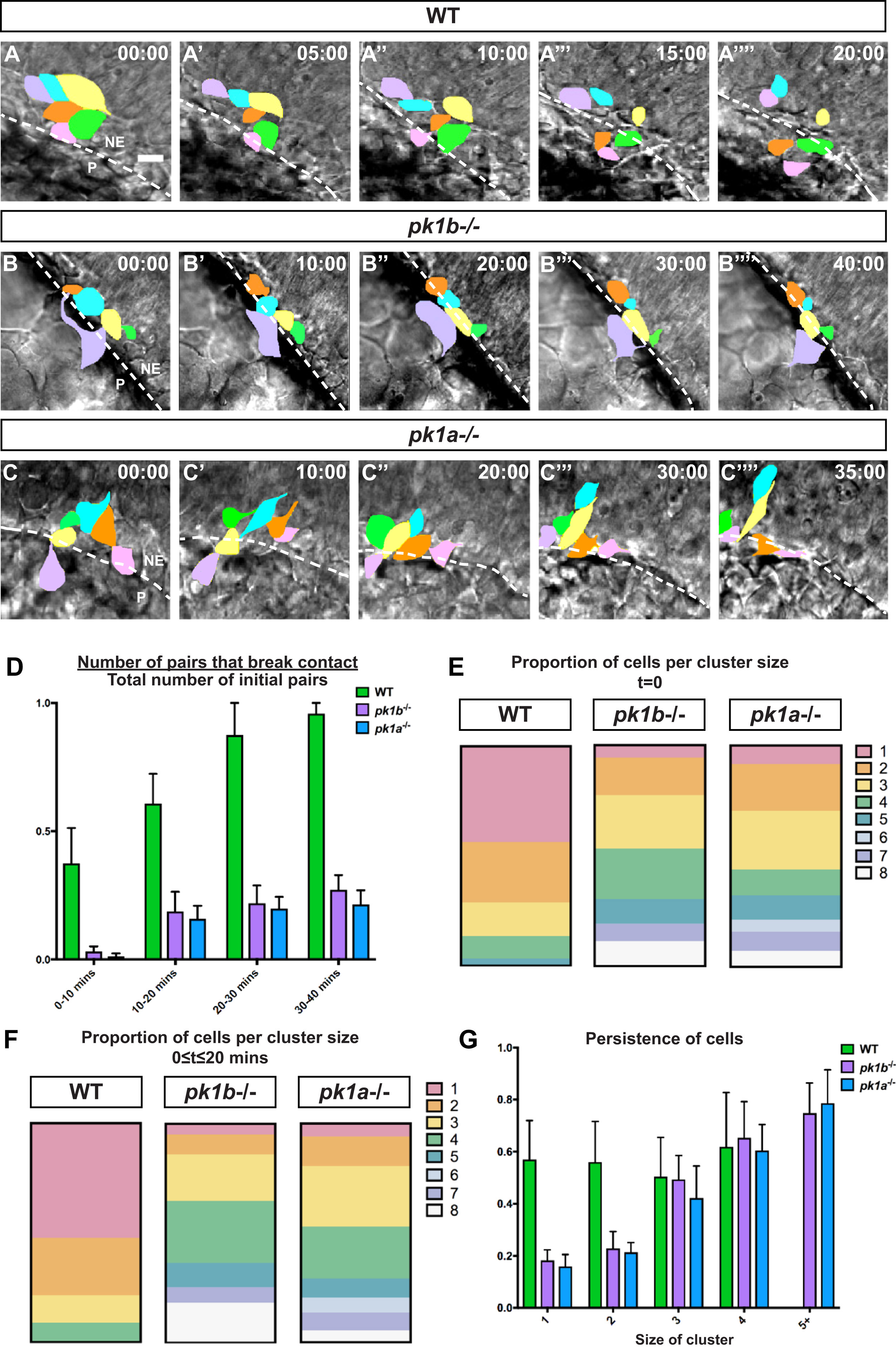Fig. 7
Loss of Pk1 function causes dorsal NCC clusters to form and be maintained in early stages of neural crest development. Confocal time-lapse imaging of dorsally-mounted Tg(sox10:EGFP) embryos was started at 12 hpf when the neural keel is still developing, with both EGFP and DIC (brightfield) images collected every 5?min. (A-C) Reorganization of EGFP+?NCCs (pseudocolored) in clusters of NCCs at t?=?0 to t?=?40?mins; dotted line indicates border of the neuroepithelium. The neuroepithelium (NE) is located at top right, and the periphery (P) is located at bottom left, in all panels. Scale bar=?10?Ám. (A) In WT embryos, many of the NCCs in contact at t?=?0 break contact by 20?min, with almost all contacts breaking by 30?mins and 40?mins. (B, C) In pk1b fh122/ fh122 and pk1ach105/ch105 specimens NCC clusters largely remained in contact for 40?mins. (D) To quantify breakage of contacts between NCCs over the time intervals 0?10?min, 10?20?min, 20?30?min and 30?40?min, a ratiometric measure of ?pair breakage? within a cluster was used (Methods). In WT embryos, ~?61% of pairs of cells broke contacts between 0 and 20?min (n?=?43 pairs, 3 embryos), with a large majority of pairs losing contact by 20?30?min. In contrast, pairs of NCCs in both pk1b fh122/ fh122 (n?=?61 pairs, 3 embryos) and pk1ach105/ch105 embryos (n?=?58 pairs, 3 embryos) did not break over extended periods of time, with only ~?27% of pairs in pk1b fh122/ fh122 clusters breaking contact and ~?21% of pairs in pk1ach105/ch105 clusters breaking contact by 30?40?min. (E) To measure the relative proportions of individual cells and cell clusters of varying sizes, the organization of cells at 12 hpf in Tg(sox10:EGFP) embryos was quantified. In WT embryos (n?=?37 cells, 3 embryos), 43.9% of NCCs were found as individuals, 27.6% were in pairs, 15.3% in clusters of 3 cells, 10.2% in clusters of 4 cells, and 3.1% in clusters of 5 cells. In pk1b fh122/ fh122 specimens (n?=?53 cells, 3 embryos), 5.9% of NCCs were found as individuals, and 17.0% as pairs. Most NCCs were found in cluster sizes of 3 (24.2%) or 4 (22.9%), with clusters consisting of as many as 8 cells. In pk1ach105/ch105 specimens (n?=?46 cells, 3 embryos), 8.6% of NCCs were found as individuals, and 21.1% as pairs. Most NCCs were found as pairs or in cluster sizes of 3 cells (26.6%), with appreciable percentages of cluster sizes of 4 (11.7%) and 5 (10.9%) and with clusters consisting of as many as 8 cells. (F) As another measure of the relative proportions of individual cells and clusters of varying sizes, the number of cells that persisted in a given configuration (from an individual cell to cells in increasing sizes of clusters) was measured over non-overlapping 20-min time windows. In WT embryos (n?=?117 cells, 3 embryos), 53.8% of NCCs remain individual over 20?min, whereas 26.5% were in pairs, 11.1% in clusters of 3 cells, and 8.5% in clusters of 4 cells. In pk1b fh122/ fh122 embryos (n?=?99 cells, 3 embryos), 5.05% of NCCs were found as individual cells over the 20-min time window. Most NCCs were found in cluster sizes of 3 (21.2%) or 4 (28.3%), with NCCs found in clusters consisting of as many as 8 cells. In pk1ach105/ch105 embryos (n?=?148 cells, 3 embryos), 6.1% of NCCs were individual, with most NCCs found in cluster sizes of 3 (27.7%) or 4 (23.6%) and clusters consisting of as many as 8 cells. (G) To assay how persistence?a measure of the total length of a trajectory of a cell as a ratio of the displacement of the cell with a value of 1.0 indicating a targeted route from starting point to end point?varied as a function of cluster size, the persistence of individual cells and clusters of sizes 2 or more was measured for each condition. Persistence is agnostic to the ?correct? direction of the cells, and is a measure of the targeted directionality of NCCs, independent of their trajectories. In WT embryos (n?=?42 cells, 3 embryos), the persistence of individual NCCs or clusters of 2, 3 or 4 was similar. In both pk1b fh122/ fh122 (n?=?49 cells, 3 embryos) and pk1ach105/ch105 embryos (n?=?64 cells, 3 embryos), the persistence of individual cells and cells in pairs was lower than the persistence of clusters consisting of 3 or more NCCs, or of WT NCCs. Clusters of 3 or more NCCs in both pk1-mutants showed high levels of persistence, with statistically insignificant (p?>?0.5) differences in persistence as compared to WT cells. Both pk1-mutants showed small increases in persistence as the size of the cluster increased, with no statistically significant difference between clusters of 5 or more cells.
Reprinted from Developmental Biology, 448(1), Ahsan, K., Singh, N., Rocha, M., Huang, C., Prince, V.E., Prickle1 is required for EMT and migration of zebrafish cranial neural crest, 16-35, Copyright (2019) with permission from Elsevier. Full text @ Dev. Biol.

